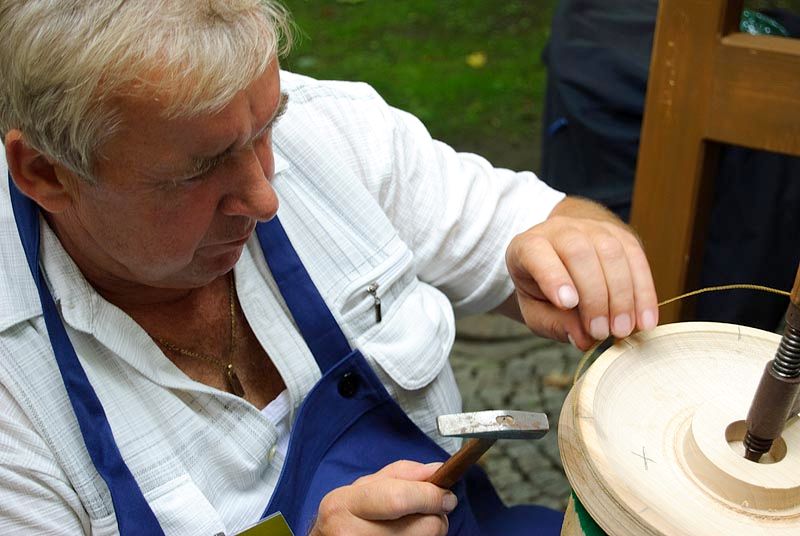He has been devoted to folk art production since a young age. Certainly also thanks to the influence of his family, when he had two inspirations in his close circle - uncles Jozef Hupka, a master maker of straw ornaments, and Michal Hupka, a master turner, both long-time active collaborators of the ÚĽUV. He was especially enchanted by the work...
He has been devoted to folk art production since a young age. Certainly also thanks to the influence of his family, when he had two inspirations in his close circle – uncles Jozef Hupka, a master maker of straw ornaments, and Michal Hupka, a master turner, both long-time active collaborators of the ÚĽUV. He was especially enchanted by the work of the latter. Perhaps also because in his youth, working with wood on the lathe was very popular among his peers.
This trained electromechanic with a construction school intensively sought out his uncle’s workshop in Sereď from 1976 after returning from basic military service. He was fascinated by the fact that his uncle only left his workplace a few times a month when he went to ÚĽUV to deliver his products. Otherwise, he consistently created, in tandem with his wife Božena, who decorated the finished products by beating brass sheet decorations.
A notable feature of the work of this inseparable duo was their attention to detail and precision. “I still remember how my uncle threw a completed bowl into the furnace because there was a hidden flaw, a small crack in it. He didn’t let go of imperfect products nor did he try to sell them because he was convinced that paying customers expect one hundred percent quality work,” recalls Eduard Hupka, reflecting on years of experience. And he maintains a similar approach to his craft today, in keeping with family tradition.
His craftsmanship can already be seen in the material preparation phase. He owns all the tools needed to process wood, which he selects even as it grows in its roots. After cutting it down, he lets the tree dry out for a year, then cuts it into blanks on his own sawhorse and stores it in the yard. It dries further in the air for more years, gradually processed into semi-finished products on the lathe, which are then left to dry freely again. Properly dried wood is for Eduard Hupka simply a guarantee of the quality and stability of the final shape.
As for the products, in the early stages of his work, he continued in his uncle’s assortment, from whom he also adopted the decorative technique of beating brass sheet decorations. Later, he enriched his portfolio with his own shapes, perfecting them mainly on bowls and candlesticks. Brass sheet cut into thin strips with one edge ground is shaped on a manually made wavy plate from gear wheels. He also sharpens and hones knives and chisels and makes his own metal bowls, which are part of his candlesticks.
During the finishing of the products, he sometimes uses black ink, which, in contrast, further highlights the natural color of the wood – most commonly walnut, but he also favors ash or fruit trees. Each wood is unique to him, especially in density and color, but the plum and apple trees stand out the most on the pedestal of his long experience.
He finalizes the product by sanding it with fine sandpaper and applying surface protection – in the past, shellac mixed with denatured alcohol, today more likely beeswax or linseed oil.
The love for wood was inherited from his father by his daughter Zuzana Danišková, who studied design and wood shaping at the School of Applied Arts of Josef Vydra in Bratislava and later at the Academy of Fine Arts. Seemingly unnecessary scraps from the works of the master of folk art production find their use in further original author’s creations.
Source: Mikolaj, Tomáš: Masters of the New Millennium. Bratislava: Center of Folk Art Production, 2020. Available at: https://uluv.sk/kniznica/digitalna-kniznica/
In 2018, he received a certification from the ÚĽUV for the qualification of a folk art producer in the field of turning, granted by the commission for assessing workers in folk art production.
For more information about the producer, see Martina Bizovska’s article “Turning at Heart” in the RUD magazine 1/2019

















